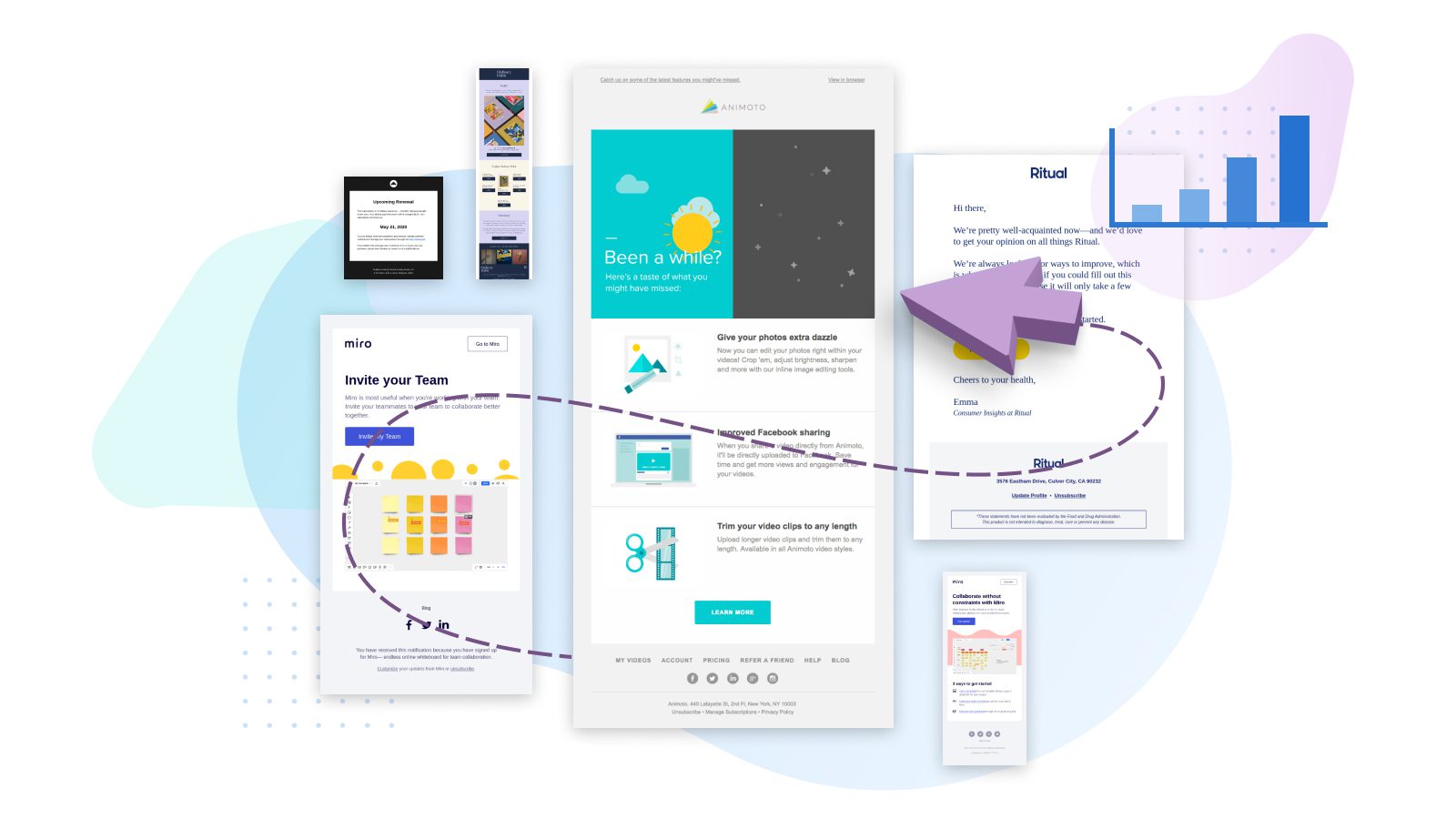According to Omnisend, automated email campaigns drove 29% of all email orders in 2020, despite making up less than two percent of emails. They’re also 77% more likely to be opened and 152% more likely to generate click-throughs, compared to other email marketing campaigns.
In other words, automated email campaigns are an incredibly effective tool for increasing revenue and building customer loyalty and engagement.
While these numbers are impressive, you probably already know email automation is a useful tool. According to Leadspace, 82% of companies are using it to some extent. But it’s not as simple as flicking a switch — you need a strategy to ensure your automated emails are timely, relevant, and compelling.
So in this article, I’ll share some best practices, ideas, and examples to help you get the most out of your email marketing automation platform. But first, let’s get clear on a few key definitions.
Triggered versus automated email campaigns
In short, an automated email campaign is an email (or series of emails) sent to your subscribers, based on predetermined parameters.
It’s kind of like a Rube Goldberg machine. You set up the sequence, decide what sets it in motion, and then watch as it executes a complex and elegant series of actions designed for maximum awe!
Okay, maybe that was just an excuse to link to my favorite OK Go video. But I stand behind the analogy: Automation takes something too complicated to achieve on a case by case basis — sending personalized, perfectly-timed emails to each customer — and makes it happen, with a little planning and the right tools.
Triggered emails (also called autoresponders) are a subset of automated email campaigns. These emails are activated by a specific customer action (or “trigger”), like signing up for your email list or abandoning a cart.
But automation doesn’t require your customer to make the first move the way a triggered email does. You can set up automated email campaigns based on information in your customer’s profile, like their interests, purchase history, or loyalty data. You can also plan them around particular dates or events, like an onboarding series or an upcoming webinar.
Really, you can automate a campaign based on anything you want. But if your goal is to create a high-performing campaign that nurtures leads, engages customers, or increases your revenue, you’ll want to follow a few golden rules…
Best practices for crafting high-performing automated campaigns
1. Consider the buyer journey
Your automated email campaigns should correspond to each part of your customer journey.
Consider the touch points you have with each customer. These include when they sign up for your email list, read their first blog post, make their first purchase, and so on.
Imagine you’re having a real-life conversation with them at each of these moments: What would you want to tell them? What questions would they have? What might they need to know next?
These questions should guide your strategy. To put it simply, don’t just think about what you want to say; think about what your customer needs to know.
2. Personalize, personalize, personalize
It’s no secret personalization is important. In fact, 90% of customers appreciate personalized content from brands.
Beyond first name, there are endless ways to personalize your automated email campaigns. You can provide tailored product recommendations, educational content based on customer interests, or customized discount codes to celebrate birthdays.
It can start before they even click on the email: Personalized subject lines are 26% more likely to be opened.
Personalization is powerful, but it doesn’t have to be difficult: An email builder like Dyspatch integrates with your customer data platform, so you can pull dynamic content right into your email templates.
3. Always offer value
Every email should have a specific purpose, whether you’re aiming to entertain, remind, inform, or connect. Don’t feel obligated to send a certain number of emails if you don’t have something of value to share. As the old saying goes, quality over quantity.
4. Elevate your copy
Just because your emails are automated, doesn’t mean your email content should sound robotic or generic.
It’s possible to send emails en masse that have personality, though it takes some skill to craft them. Ultimately, you want your customer (or potential customers) to open the email and feel like you wrote it just for them.
If you’re using the principles above — thinking about their journey, personalizing your email, and prioritizing value — you’re off to a great start. From there, you just need to find your voice.
These five foundational copywriting tips can help you do just that.
5. Refine your designs
Your automated campaigns are going to reach a lot of people, so make sure your design is as enticing as your email copy.
You’ll find eight principles of engaging email design here. The last one is especially important: Ensure your design is responsive and mobile-friendly.
This is true of every email you send, but automated email campaigns raise the stakes. After all, there’s nothing like realizing your carefully-crafted email looks wonky on mobile devices after you’ve sent it to thousands of people.
6. Make it interactive
Did you know more than half of email recipients want interactive content in their emails?
Interactive emails are not only engaging, they also generate twice as many conversions as static content. And with AMP for Email, you can take interactivity a step further and create dynamic, personalized emails that transform your customer communications.
How? AMP emails deliver live, up-to-date content and reduce friction by empowering customers to take action, right from an email.
Your customer is more likely to fill out a product review form, RSVP for an event, or complete a purchase if they can do it from their inbox. So including AMP in your automated email campaigns will make them more engaging, and ultimately, increase your conversion rates.
Just like personalization, implementing AMP for Email doesn’t have to be difficult: With Dyspatch, you get access to a library of pre-coded interactive email apps that you can drag-and-drop into your ecommerce emails, transactional messages… or any types of email for that matter!
7. Measure your impact
Once you’ve set up your automated email campaigns, you’re finished.
Just kidding!
Of course, email marketing is an iterative process. You should always be testing, refining, and analyzing your email marketing strategy. This can include following certain email marketing etiquettes like tweaking your send intervals, the time of day your emails are delivered, your subject lines, and so much more.
The saying “If it ain’t broke, don’t fix it” doesn’t really apply to email. It’s always worth tinkering with your formula and performing A/B tests to see if there’s room to improve key metrics. The truth is, even your best emails may lose their impact if you neglect them.
Back to A/B testing… Make sure you’re testing one change (and one change only!) at a time, like your CTA button color or your subject line, so you can pinpoint which option leads to better conversion rates.
7 essential automated email campaigns
1. Warm welcome emails
The welcome email is a classic, and with good reason: It gets terrific engagement, and it’s the first (and most important) impression you make on your new subscribers.
This first email should be sent immediately after your customer signs up or purchases. Here’s a great example from Ordinary Habit, which has a dreamy design, a selection of helpful links, and an intro to their brand values.

It’s almost perfect, except for one thing. Did you notice what it is? If you missed it, I’ll tell you: The paragraph under ‘Our Story’ is duplicated. This is the kind of error that can happen when you don’t establish a collaborative workflow and feedback process.
I still love this email. It makes me want to pour a beer and break out a puzzle. But it’s a useful reminder about the importance of checking (and re-checking) your emails before you automate them.
2. Helpful onboarding sequences
Onboarding email sequences offer education at regular intervals, anticipating your customer’s learning curve and providing information when it’s needed.
The key to a really smart onboarding series? Segmentation. You should be sending different sequences of emails to users, based on their engagement with your emails and products.
For instance, Miro sends a welcome email with three easy steps to get started:
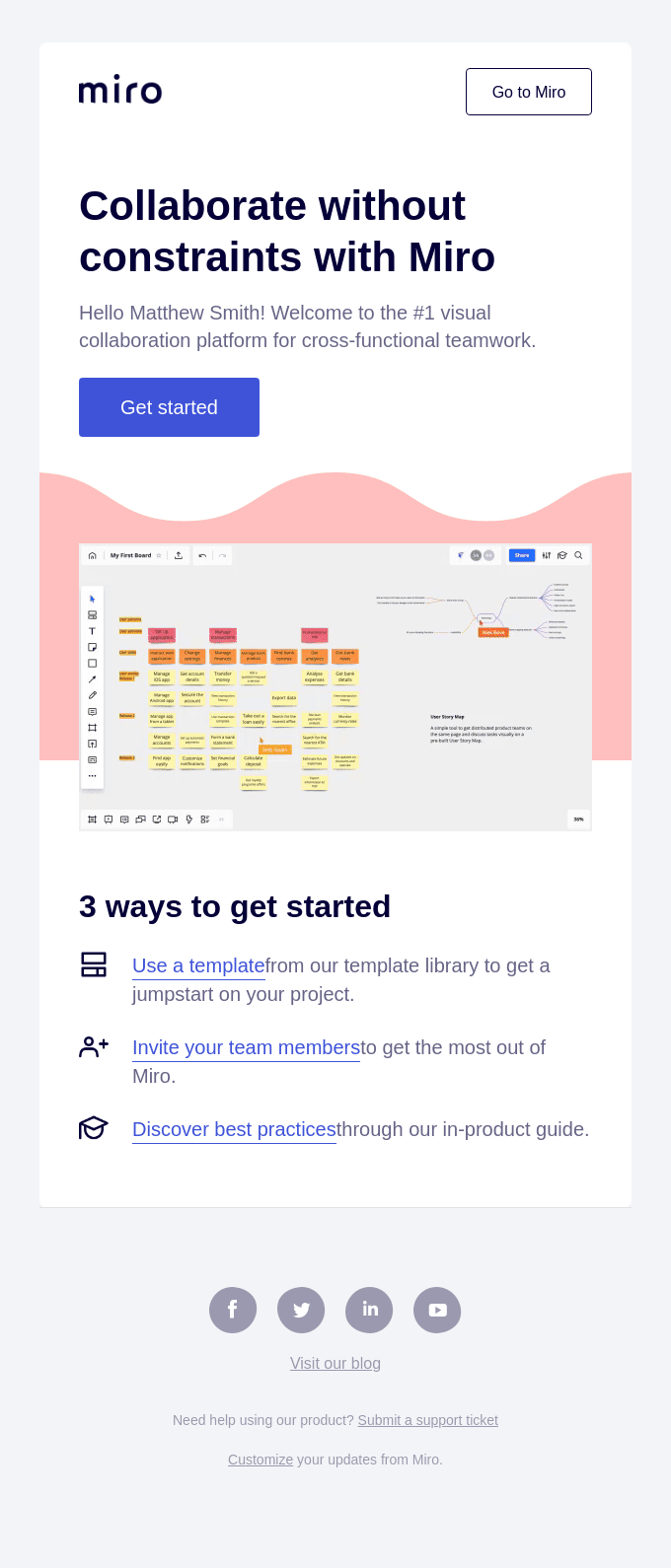
Then, they have a follow-up to nudge users to invite their team members. But if someone has already invited their team members, they wouldn’t get this second email.
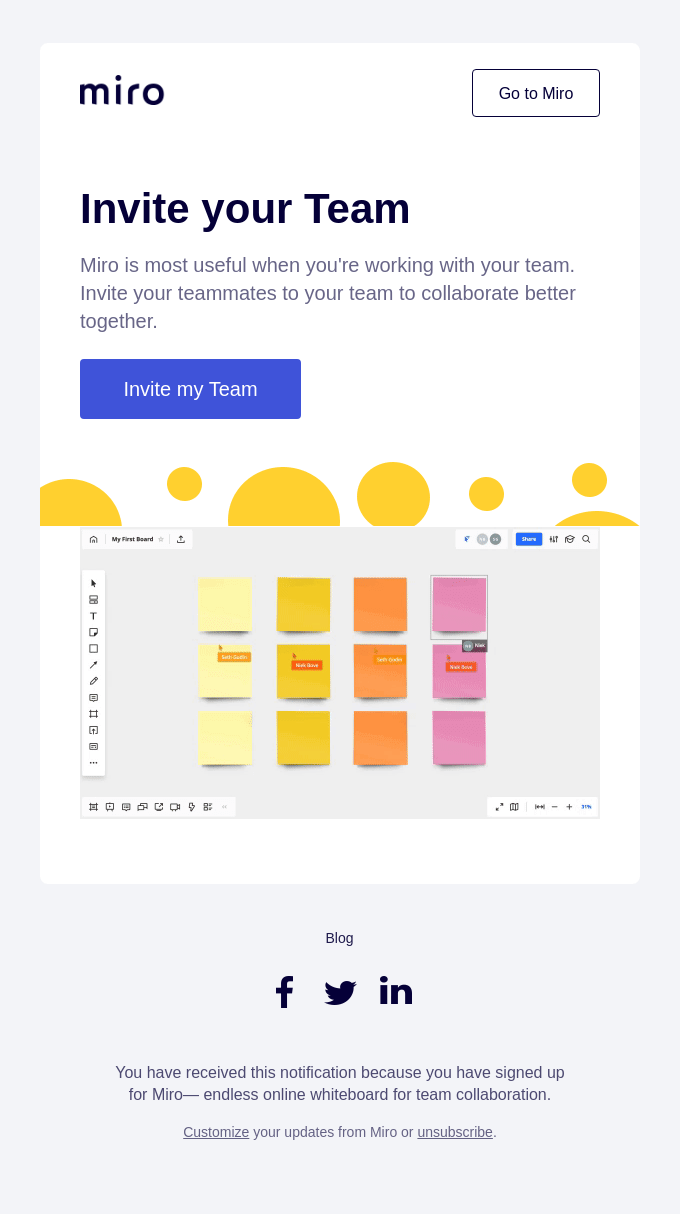
You should also segment your onboarding campaign based on user activity. Someone who’s clicking and reading every email and actively using your products will probably appreciate more emails in their onboarding.
The same approach is less likely to work for an inactive user. Instead, you might send an onboarding series that includes incentives or offers one-on-one help to get started.
At minimum, you should have two different sequences: One for users who are highly engaged with your emails, versus those who are less engaged and may prefer fewer communications.
3. Timely review requests
Getting positive reviews isn’t just good for your ego — it’s good for your brand.
Ninety-one percent of customers read reviews before making a purchase. And though negative reviews might sting, they provide an opportunity to improve in the future.
Automated campaigns can help you ask for feedback at the right times. That is, when your customers are especially likely to have something to say.
For instance, you could automate a campaign asking for a product review shortly after a customer receives a new item. Or, invite your customers to write a testimonial after they refer another customer to your business.
Service or subscription-based businesses can also check in at specific intervals, like after a customer has upgraded their account. Automating this process makes it easy to gather more reviews.
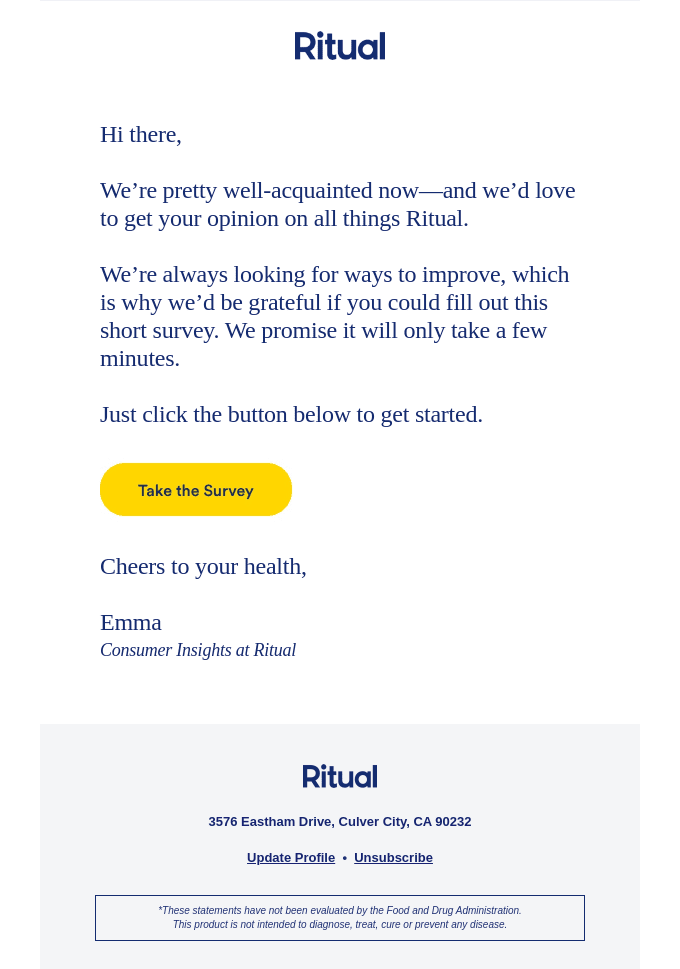
Review requests and customer feedback emails are also the perfect place to incorporate interactive elements. With AMP for email, your customers can fill out a feedback form or write a product review, right from their inbox. And the easier it is to submit a review, the more likely they are to do it.
4. Targeted re-engagement campaigns
Every business loses some customers to churn.
But automated campaigns can help you retain more customers, by understanding why they’re dissatisfied or disengaged and providing solutions. It’s a worthwhile effort: Increasing customer retention by 5% can boost profits by 25 to 95%.
There are many effective email tactics you can try here. For instance:
- Extending a trial period
- Offering a special discount code or referral offer
- Announcing a new feature or product update
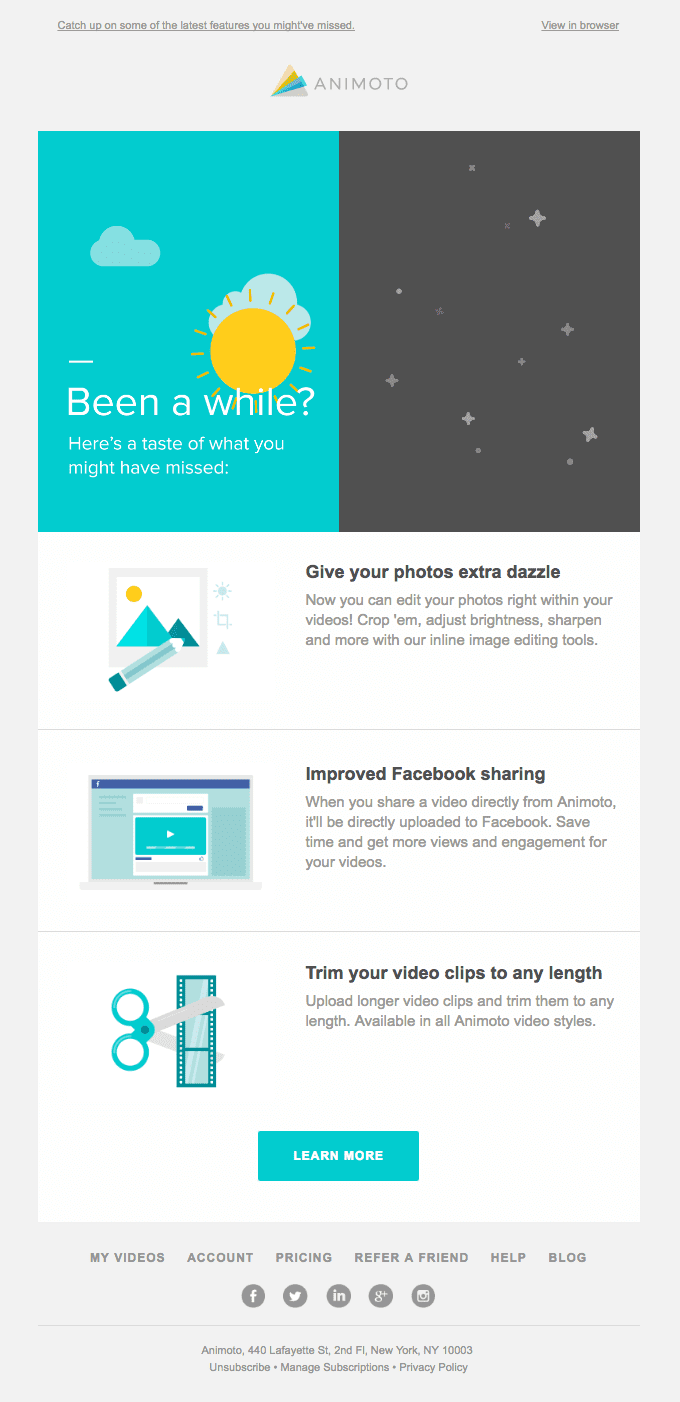
In this case, you want to plan your automated email campaign based on an elapsed period of time. That is, since the last purchase or engagement.
Re-engagement campaigns (sometimes simply called ‘engagement emails’) are a great place for marketers to A/B test retention strategies. Then, you can incorporate them earlier in the lead nurturing process and reduce your churn.
These tactics won’t work every time, so make sure you include an opportunity for customer feedback. Ask your customer to tell you why they’re no longer interested. Even if you can’t win them back, you can apply insights from their experience to your overall strategy.
5. Quality content series
If content creation is a big part of your digital marketing strategy, you should be sharing it with your subscribers… and not just through your regular email newsletter.
Showcase your best content in your automated email campaigns. This is a great way to boost the visibility of your blog posts, social media posts, and videos: Email subscribers are 3.9 times more likely to share blog content, compared to other readers.
Do you have seasonal posts that experience traffic peaks at particular times a year? Automate your email campaign to share them at precisely the right moment.
Most customers want to shop with brands that share their values. So content exploring your company mission and the causes you support could also make for a great email series.
If blogging isn’t a key part of your digital strategy, think about how you can build an automated campaign with high-quality content that’s exclusive to email subscribers.
For example, you could share exclusive stories, like this beautiful artist highlight and Q&A from retailer Moment.

This type of content rewards highly-engaged readers, and offers something of value they can’t get through any other marketing channel — a surefire reason to keep opening your emails. (And keep your open rates and click-through rates up!)
6. Important date reminders
Automated email campaigns are ideal for staying on top of important dates, like renewal notices and payment reminders.
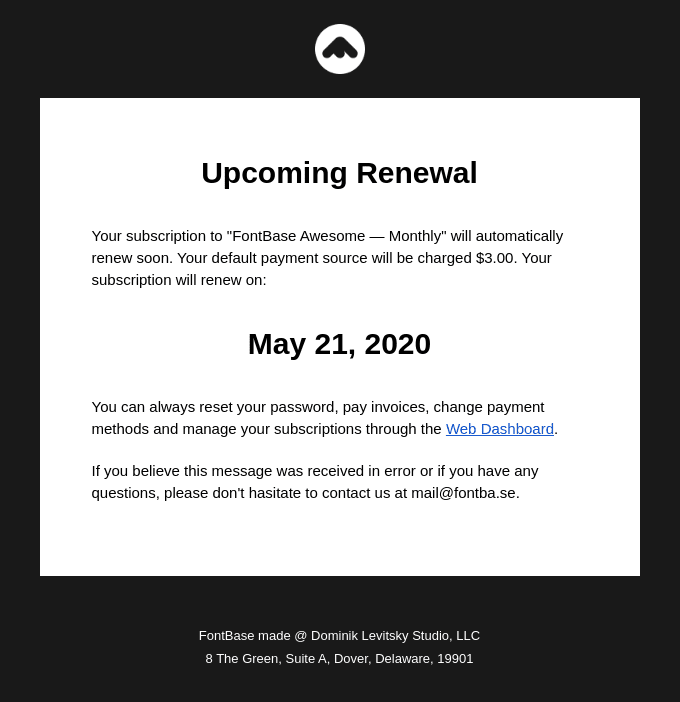
But you can also automate other important dates, like customer anniversaries or birthdays.
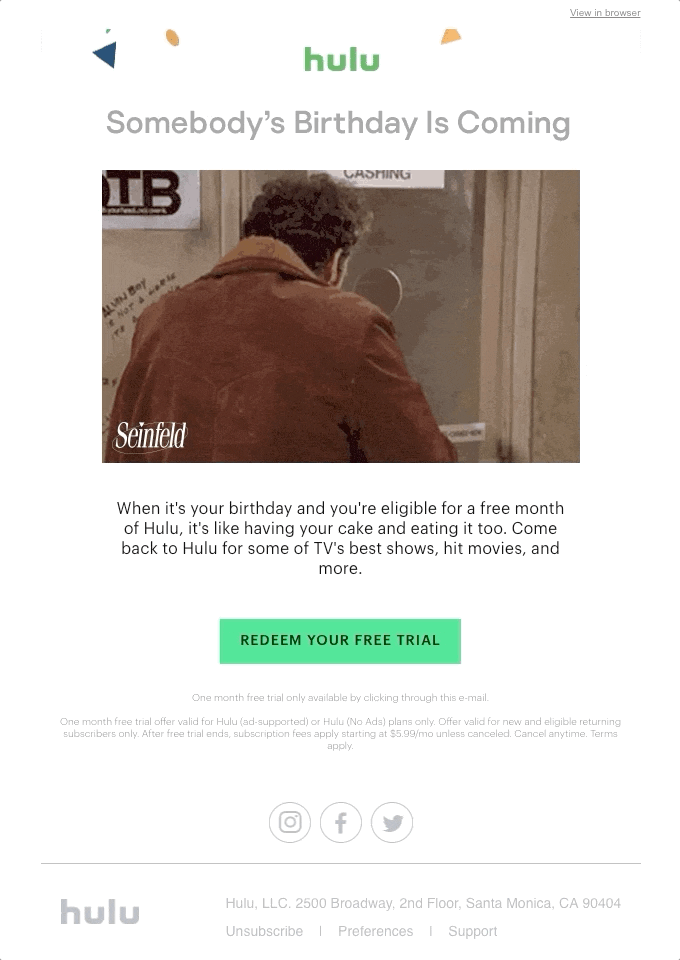
Renewal notices are important, but celebratory messages make customers feel special — and they work. In fact, birthday emails generate 342% as much revenue as other promotional emails.
If you’re offering a birthday or anniversary reward, an automated email drip campaign can help remind your customer to redeem their offer. Try sending one email a week in advance, one the day of, and one a week after with a final reminder.
Just don’t forget to freshen up these campaigns at least once a year… especially, if you’re sending an anniversary campaign. You wouldn’t want to send the same message two years in a row!
7. Abandoned cart campaigns
Seventy seven percent of all online shopping carts get abandoned. So if you’re an ecommerce company, you should definitely have an automated cart abandonment campaign in place to remind your customers of what they left behind.
Unlike many emails, abandoned cart campaigns have a universal formula for success. This article breaks it down: Three abandoned cart emails, sent at specific intervals, with slightly different messaging.
Of course, you should still tweak this formula to find out what works best for your customers… I stand by the recommendation to never stop refining your strategy. Just promise to let me know if you find an even better formula.
Stop Dreaming, Start Automating
If this post didn’t give you one new idea, I owe you a sprinkle doughnut! But I’m willing to bet you have a few new ideas for how to level up your automated email campaigns.
Wondering how to set up an automated email campaign? Check out this article for an overview of the best marketing automation software out there.
P.S. Each of them integrate with Dyspatch, the leading no-code email builder where you can create engaging, interactive experiences in minutes. With the right email marketing software, your campaigns will be up and running in no time.
